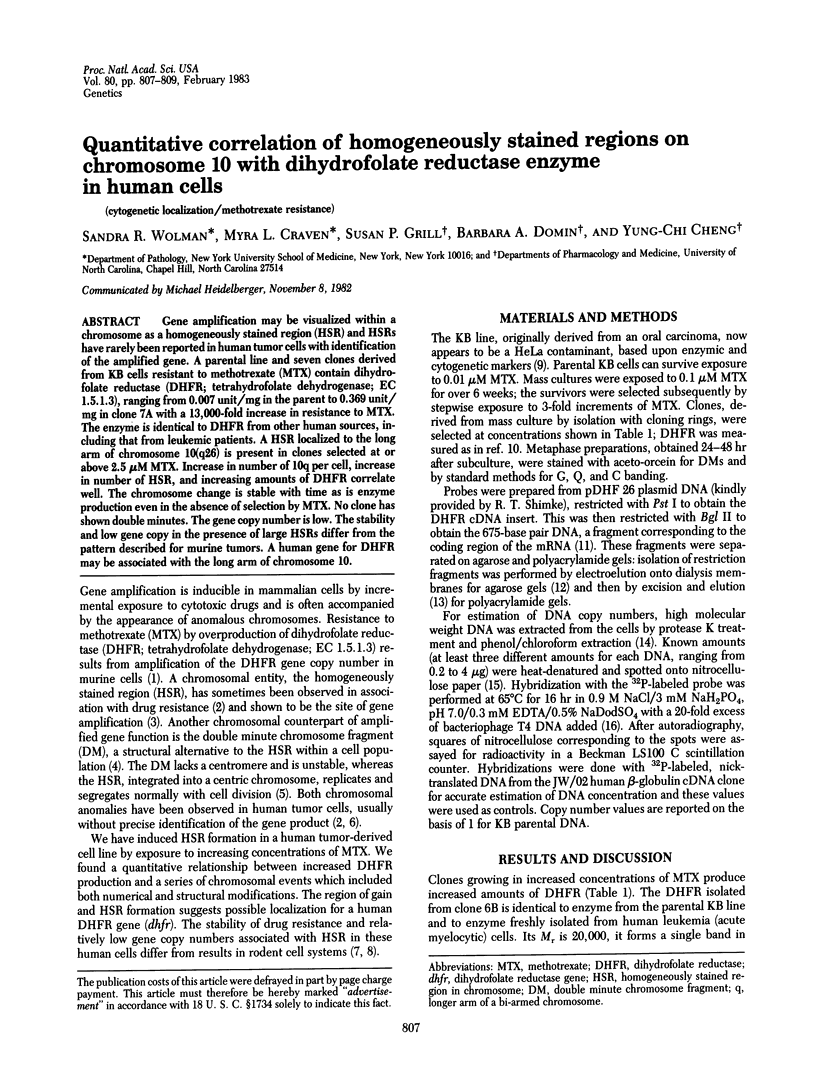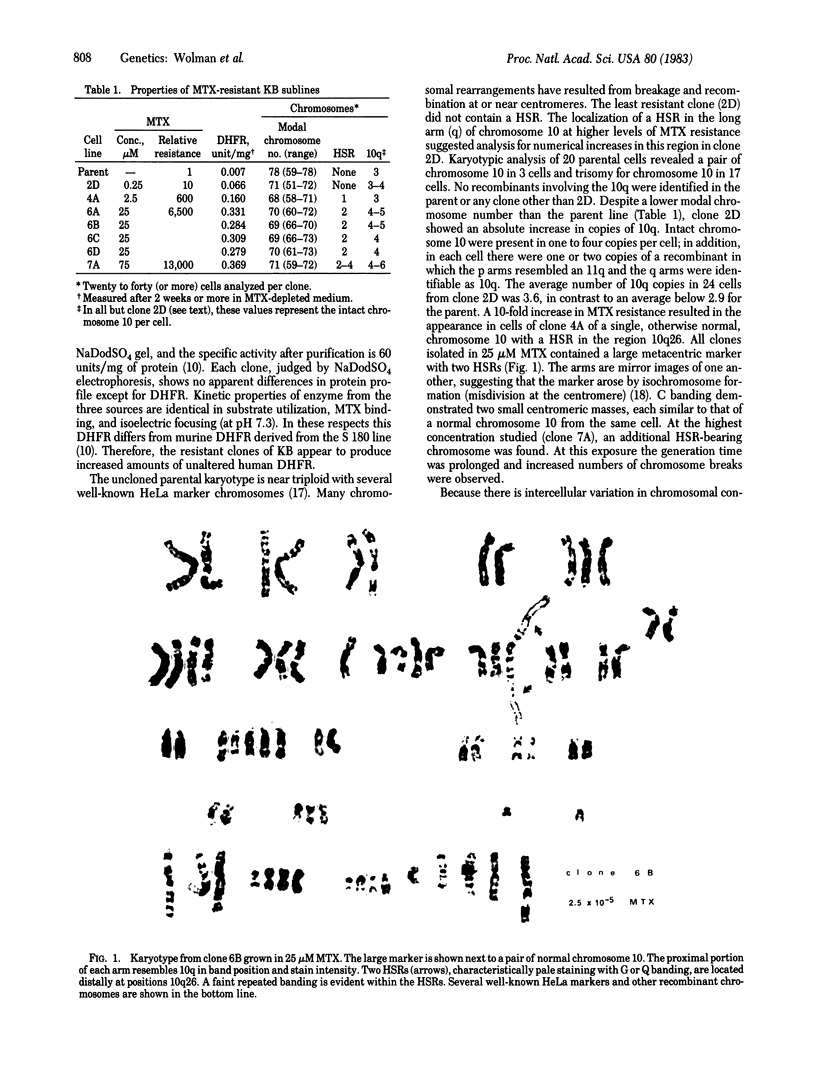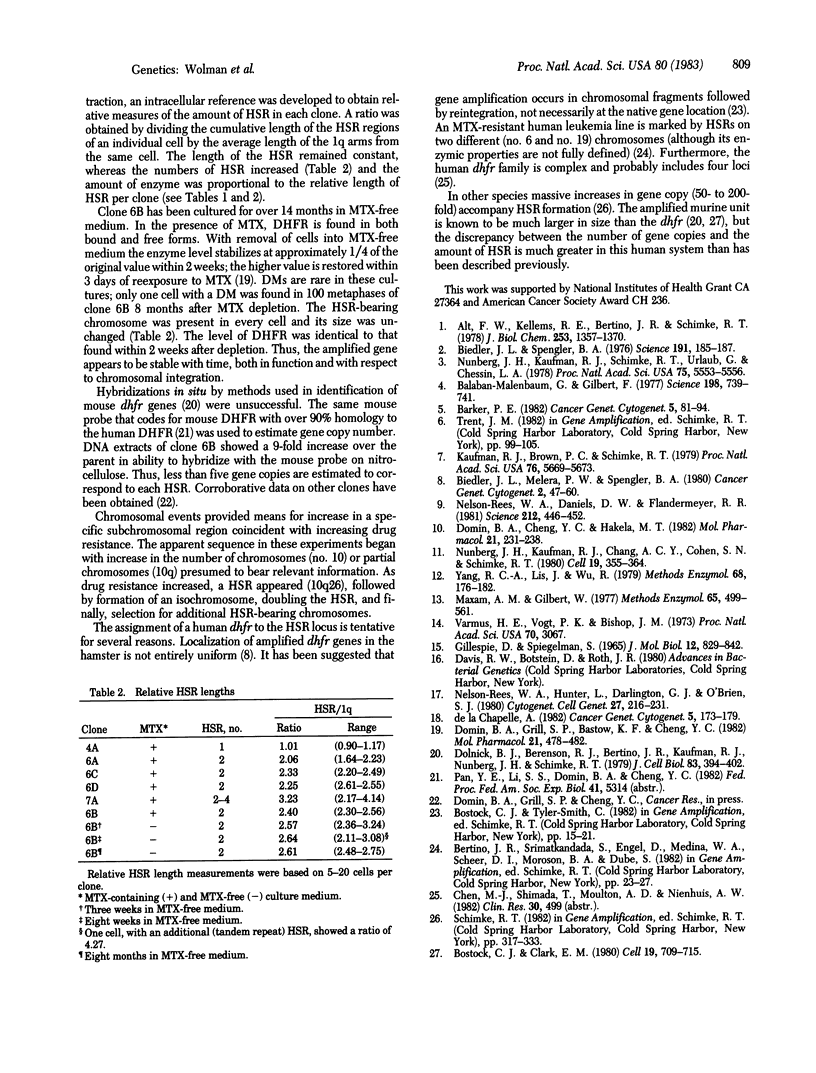Abstract
Gene amplification may be visualized within a chromosome as a homogeneously stained region (HSR) and HSRs have rarely been reported in human tumor cells with identification of the amplified gene. A parental line and seven clones derived from KB cells resistant to methotrexate (MTX) contain dihydrofolate reductase (DHFR; tetrahydrofolate dehydrogenase; EC 1.5.1.3), ranging from 0.007 unit/mg in the parent to 0.369 unit/mg in clone 7A with a 13,000-fold increase in resistance to MTX. The enzyme is identical to DHFR from other human sources, including that from leukemic patients. A HSR localized to the long arm of chromosome 10(q26) is present in clones selected at or above 2.5 microM MTX. Increase in number of 10q per cell, increase in number of HSR, and increasing amounts of DHFR correlate well. The chromosome change is stable with time as is enzyme production even in the absence of selection by MTX. No clone has shown double minutes. The gene copy number is low. The stability and low gene copy in the presence of large HSRs differ from the pattern described for murine tumors. A human gene for DHFR may be associated with the long arm of chromosome 10.
Full text
PDF


Images in this article
Selected References
These references are in PubMed. This may not be the complete list of references from this article.
- Alt F. W., Kellems R. E., Bertino J. R., Schimke R. T. Selective multiplication of dihydrofolate reductase genes in methotrexate-resistant variants of cultured murine cells. J Biol Chem. 1978 Mar 10;253(5):1357–1370. [PubMed] [Google Scholar]
- Balaban-Malenbaum G., Gilbert F. Double minute chromosomes and the homogeneously staining regions in chromosomes of a human neuroblastoma cell line. Science. 1977 Nov 18;198(4318):739–741. doi: 10.1126/science.71759. [DOI] [PubMed] [Google Scholar]
- Barker P. E. Double minutes in human tumor cells. Cancer Genet Cytogenet. 1982 Feb;5(1):81–94. doi: 10.1016/0165-4608(82)90043-7. [DOI] [PubMed] [Google Scholar]
- Biedler J. L., Spengler B. A. Metaphase chromosome anomaly: association with drug resistance and cell-specific products. Science. 1976 Jan 16;191(4223):185–187. doi: 10.1126/science.942798. [DOI] [PubMed] [Google Scholar]
- Bostock C. J., Clark E. M. Satellite DNA in large marker chromosomes of methotrexate-resistant mouse cells. Cell. 1980 Mar;19(3):709–715. doi: 10.1016/s0092-8674(80)80047-x. [DOI] [PubMed] [Google Scholar]
- Dolnick B. J., Berenson R. J., Bertino J. R., Kaufman R. J., Nunberg J. H., Schimke R. T. Correlation of dihydrofolate reductase elevation with gene amplification in a homogeneously staining chromosomal region in L5178Y cells. J Cell Biol. 1979 Nov;83(2 Pt 1):394–402. doi: 10.1083/jcb.83.2.394. [DOI] [PMC free article] [PubMed] [Google Scholar]
- Domin B. A., Cheng Y. C., Hakala M. T. Properties of dihydrofolate reductase from a methotrexate-resistant subline of human KB cells and comparison with enzyme from KB parent cells and mouse S180 AT/3000 cells. Mol Pharmacol. 1982 Jan;21(1):231–238. [PubMed] [Google Scholar]
- Domin B. A., Grill S. P., Bastow K. F., Cheng Y. C. Effect of methotrexate on dihydrofolate reductase activity in methotrexate-resistant human KB cells. Mol Pharmacol. 1982 Mar;21(2):478–482. [PubMed] [Google Scholar]
- Gillespie D., Spiegelman S. A quantitative assay for DNA-RNA hybrids with DNA immobilized on a membrane. J Mol Biol. 1965 Jul;12(3):829–842. doi: 10.1016/s0022-2836(65)80331-x. [DOI] [PubMed] [Google Scholar]
- Kaufman R. J., Brown P. C., Schimke R. T. Amplified dihydrofolate reductase genes in unstably methotrexate-resistant cells are associated with double minute chromosomes. Proc Natl Acad Sci U S A. 1979 Nov;76(11):5669–5673. doi: 10.1073/pnas.76.11.5669. [DOI] [PMC free article] [PubMed] [Google Scholar]
- Maxam A. M., Gilbert W. Sequencing end-labeled DNA with base-specific chemical cleavages. Methods Enzymol. 1980;65(1):499–560. doi: 10.1016/s0076-6879(80)65059-9. [DOI] [PubMed] [Google Scholar]
- Nelson-Rees W. A., Daniels D. W., Flandermeyer R. R. Cross-contamination of cells in culture. Science. 1981 Apr 24;212(4493):446–452. doi: 10.1126/science.6451928. [DOI] [PubMed] [Google Scholar]
- Nelson-Rees W. A., Hunter L., Darlington G. J., O'Brien S. J. Characteristics of HeLa strains: permanent vs. variable features. Cytogenet Cell Genet. 1980;27(4):216–231. doi: 10.1159/000131490. [DOI] [PubMed] [Google Scholar]
- Nunberg J. H., Kaufman R. J., Chang A. C., Cohen S. N., Schimke R. T. Structure and genomic organization of the mouse dihydrofolate reductase gene. Cell. 1980 Feb;19(2):355–364. doi: 10.1016/0092-8674(80)90510-3. [DOI] [PubMed] [Google Scholar]
- Nunberg J. H., Kaufman R. J., Schimke R. T., Urlaub G., Chasin L. A. Amplified dihydrofolate reductase genes are localized to a homogeneously staining region of a single chromosome in a methotrexate-resistant Chinese hamster ovary cell line. Proc Natl Acad Sci U S A. 1978 Nov;75(11):5553–5556. doi: 10.1073/pnas.75.11.5553. [DOI] [PMC free article] [PubMed] [Google Scholar]
- Varmus H. E., Vogt P. K., Bishop J. M. Integration of deoxyribonucleic acid specific for Rous sarcoma virus after infection of permissive and nonpermissive hosts. Proc Natl Acad Sci U S A. 1973 Nov;70(11):3067–3071. doi: 10.1073/pnas.70.11.3067. [DOI] [PMC free article] [PubMed] [Google Scholar]
- Yang R., Lis J., Wu R. Elution of DNA from agarose gels after electrophoresis. Methods Enzymol. 1979;68:176–182. doi: 10.1016/0076-6879(79)68012-6. [DOI] [PubMed] [Google Scholar]
- de la Chapelle A. How do human isochromosomes arise? Cancer Genet Cytogenet. 1982 Feb;5(2):173–179. doi: 10.1016/0165-4608(82)90007-3. [DOI] [PubMed] [Google Scholar]



